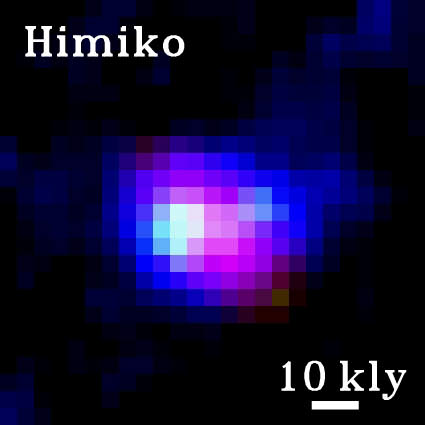
This image of the Himiko object is a composite and in false color. The bar at the lower right represents 10,000 light years. Credit: M. Ouchi et al.
Posted on 04/22/2009 4:33:54 PM PDT by LibWhacker

This image of the Himiko object is a composite and in false color. The bar at the lower right represents 10,000 light years. Credit: M. Ouchi et al.
This mysterious, giant object existed at a time when the universe was only about 800 million years old. It stretches for 55 thousand light years, a record for that early point in time. Its length is comparable to the radius of the Milky Way’s disk.
Besides being a great candidate for a future “Where in the Universe Challenge,” what is it?
 In general, objects such as this one are dubbed extended Lyman-Alpha blobs; they are huge bodies of gas that may be precursors to galaxies.
In general, objects such as this one are dubbed extended Lyman-Alpha blobs; they are huge bodies of gas that may be precursors to galaxies.
And this blob was named Himiko for a legendary, mysterious Japanese queen.
Beyond that, researchers remain puzzled. It could be ionized gas powered by a super-massive black hole; a primordial galaxy with large gas accretion; a collision of two large young galaxies; super wind from intensive star formation; or a single giant galaxy with a large mass of about 40 billion Suns. Because this mysterious and remarkable object was discovered early in the history of the universe in a Japanese Subaru field, the researchers named the object after the legendary, mysterious queen.
“The farther out we look into space, the farther we go back in time, ” explained lead author Masami Ouchi, a fellow at the Observatories of the Carnegie Institution who led an international team of astronomers from the United States, Japan and the United Kingdom. “I am very surprised by this discovery. I have never imagined that such a large object could exist at this early stage of the universe’s history.”
Ouchi adds that, according to Big Bang cosmology, small objects form first and then merge to produce larger systems. “This blob had a size of typical present-day galaxies when the age of the universe was about 800 million years old, only 6 percent of the age of today’s universe,” he said.
Extended blobs discovered before now have mostly been seen at a distance when the universe was 2 to 3 billion years old. No extended blobs have previously been found when the universe was younger. Himiko is located at a transition point in the evolution of the universe called the reionization epoch—it’s as far back as we can see to date. And at 55 thousand light years, Himiko is a big blob for that time.
This reionizing chapter in the universe was at the cosmic dawn, the epoch between about 200 million and one billion years after the Big Bang. During this period, neutral hydrogen began to form quasars, stars, and the first galaxies. Astronomers probe this era by searching for characteristic hydrogen signatures from the scattering of photons created by ionized gas clouds.
The team initially identified Himiko among 207 distant galaxy candidates seen at optical wavelengths using the Subaru telescope from the Subaru/XMM-Newton Deep Survey Field located in the constellation of Cetus. They then made spectroscopic observations to measure the distance with the Keck/DEIMOS and Carnegie’s Magellan/IMACS instrumentation.
Himiko was an extraordinarily bright and large candidate for a distant galaxy.
“We hesitated to spend our precious telescope time by taking spectra of this weird candidate. We never believed that this bright and large source was a real distant object. We thought it was a foreground interloper contaminating our galaxy sample,” said Ouchi. “But we tried anyway. Then, the spectra exhibited a characteristic hydrogen signature clearly indicating a remarkably large distance—12.9 billion light years!”
Using infrared data from NASA’s Spitzer Space Telescope and the United Kingdom Infrared Telescope, radio data from the VLA, and X-ray imaging from the XMM-Newton satellite, Ouchi and his colleagues have been able to estimate the star-formation rate and stellar mass of the galaxy and to search for an active nucleus powered by a super-massive black hole.
“We found that the stellar mass of Himiko is an order of magnitude larger than other objects known at a similar epoch, but we cannot as yet tell if the center houses an active and growing black hole,” said James Dunlop, a team member from the University of Edinburgh.
Alan Dressler, a team member from the Carnegie Institution, said it’s possible that Himiko is a member of a whole class of objects yet to be discovered.
“Because this object is, to this point, one-of-a-kind, it makes it very hard to fit it into the prevailing model of how normal galaxies were assembled. On the other hand, that’s what makes it interesting,” he said.
Ping.
The blob was named for a queen.
There’s any number of jokes in that.
________
Then again, there’s “The Blob.”
http://www.imdb.com/title/tt0051418/
“Time” has no meaning.
[and a narrow purple beak]
Looks like a globular cluster of stars or a galaxy.

· Google ·
 |
||
| · join · view topics · view or post blog · bookmark · post new topic · | ||
| Google news searches: exoplanet · exosolar · extrasolar · | ||
Disclaimer: Opinions posted on Free Republic are those of the individual posters and do not necessarily represent the opinion of Free Republic or its management. All materials posted herein are protected by copyright law and the exemption for fair use of copyrighted works.